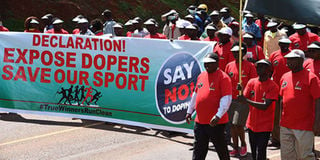Why Kenya can never go the Russia way

Stakeholders in the sports industry raise awareness on doping, in Iten, Elgeyo-Marakwet County, on November 9, 2018. PHOTO | FILE | NATION MEDIA GROUP
What you need to know:
- However, Kenya featured nowhere in the top 10 in a 2016 Wada report ranking athlete nationalities with the highest number of ADRVs.
- There have been two joint anti-doping education sessions between Athletics Integrity Unit and Adak for athletes and coaches in Nairobi and Eldoret.
On January 14, The Times, a UK-based newspaper, ran an interesting opinion piece by Rick Broadbent titled “Is it time for disgraced Kenya to follow Russia in exile?”
It said how Kenyan athletes continue being cited for anti-doping rule violations (ADRVs), the most recent case being the provisional suspension of former world marathon record holder Wilson Kipsang.
Indeed, the growing numbers of Kenyan elite runners being flagged for anti-doping transgressions should sound a warning bell to sports administrators.
However, the country cannot get to the Russian level because of various glaring reasons.
A 2017 study by the World Anti-Doping Agency (Wada) concluded that “doping practices by Kenyan athletes are unsophisticated, uncoordinated and opportunistic”.
This means the country has never tinkered with putting in place an elaborate doping machinery.
Russia’s State-sponsored doping resulted in the stripping of 43 medals from the country’s athletes so far — the largest number ever for any nation.
POOL OF TALENT
Investigations by Wada and the International Olympic Committee (IOC) had revealed ‘systematic doping’ allegedly orchestrated by KGB officials posing as anti-doping personnel.
Last year, Wada banned Russia from all major sporting events for four years. For Kenya, anti-doping samples are shipped to Qatar and South Africa for analysis.
This means there are no mediating factors between the times the sample is provided to when it arrives at the laboratory to the time when the results are relayed to the Anti-Doping Agency of Kenya (Adak).
Similarly, Kenyan anti-doping officials are continually trained by some of the world’s leading anti-doping organisations such as the UK anti-Doping (Ukad) and Norwegian body-Anti-Doping Norway (Adno).
Together with other athletics powerhouses such as Ethiopia, Kenya is ranked by the World Athletics among the countries with the highest risk of doping.
But on the flip side, this could be attributed to the fact that Kenya boasts an unrivalled pool of talent in athletics.
EDUCATION SESSIONS
Broadbent quotes Brendan Foster, a European champion and bronze medallist in the 1970s, who rightly notes that world record-shattering performances nowadays by hitherto unknown athletes raise more questions than answers.
However, Kenya featured nowhere in the top 10 in a 2016 Wada report ranking athlete nationalities with the highest number of ADRVs.
Ironically, the report placed athletics as the sport with the highest number of ADRVs by athletes.
Unbeknownst to the writer, Kenya has cooperated with the Athletics Integrity Unit (AIU), the global body charged with protecting integrity in athletics, to the extent that there have been two joint anti-doping education sessions between it and Adak for athletes and coaches in Nairobi and Eldoret.
Lastly, Kenya stared at being barred from participating in the 2016 Rio Olympics in Brazil, not because it was doing nothing about doping but it was at risk of missing strict deadlines in establishing a robust anti-doping programme.
MPs were recalled from recess to pass the Anti-Doping Act 2016, which established Adak.
Mr Mwangi is a former head of corporate communications at the Anti-Doping Agency of Kenya (Adak). [email protected].





